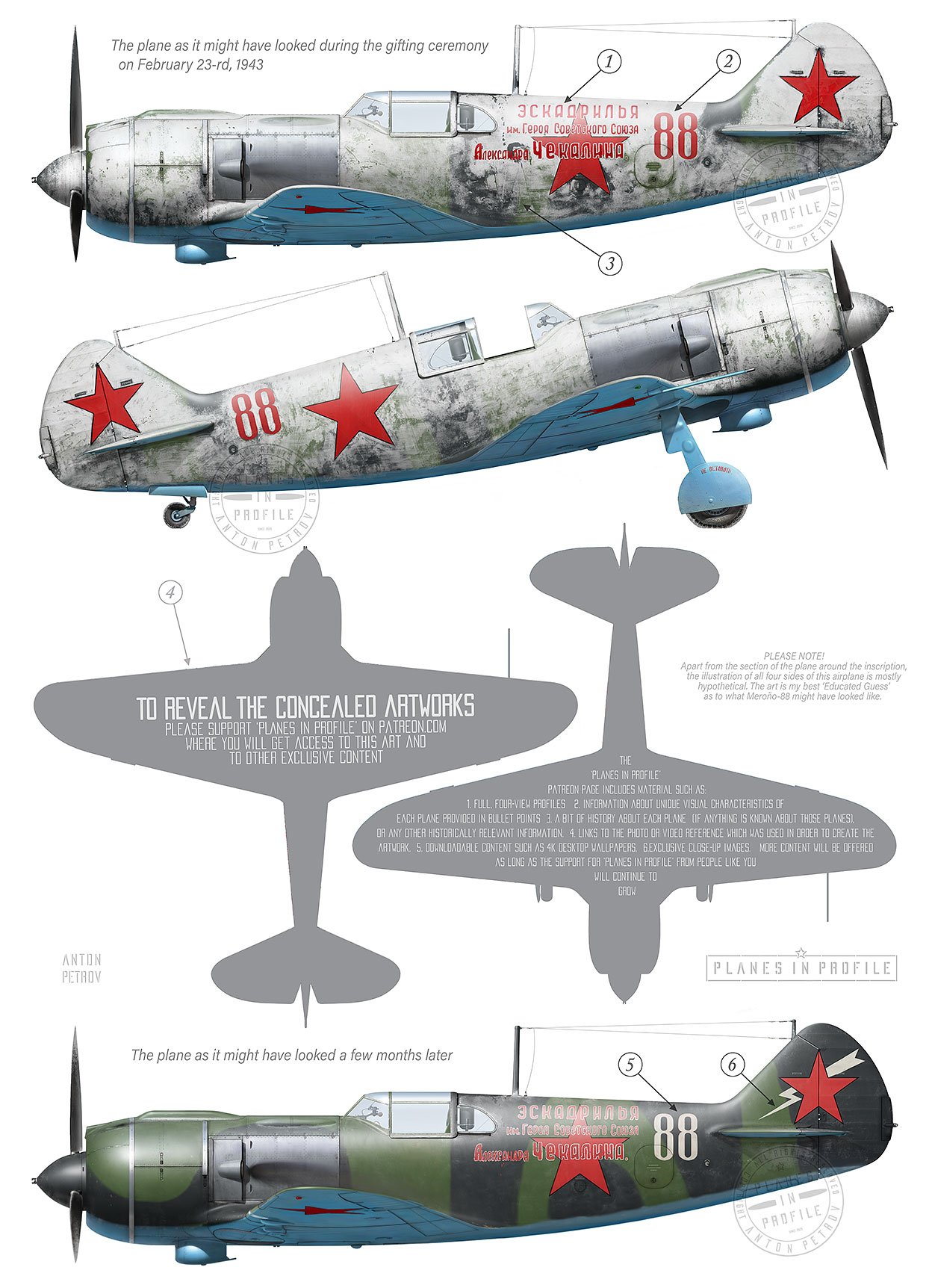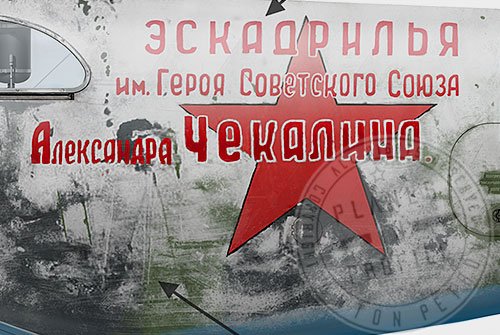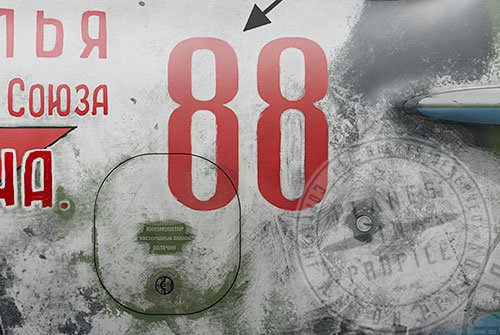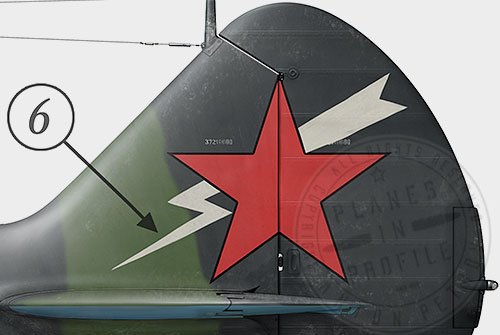Meroño’s 88, “Eskadril’ya Aleksandra Chekalina”
LAVOCHKIN, LA-5 (TYPE 37)
960-th IAP PVO, “Eskadril’ya Aleksandra Chekalina”, 125-th IAD PVO, Tulskiy district PVO, circa February 1943, near Tula.
Flown by the commander of the 1st squadron “Eskadril’ya Aleksandra Chekalina” of 960th IAP, Captain Francisco Meroño Pellicer (An Ace with (possibly) 8 victories (5 personal+1 shared confirmed victories in Spain, and 1 shared and (future) 1 personal in WW2, based on Meronyo's memoir- not based on the documents)[1])
Please Note! There exists only a small fragment of photo reference related to this airplane. The illustrations of Meronyo's plane below are mostly hypothetical.
It’s a well known fact that some Soviet pilots went to Spain to fight on the side of the Republicans during the Spanish Civil War of 1936-1939, but it is a lesser known fact that some Republican pilots (70 to 95 of them, depending on the source [2]) repaid the favour by fighting on the side of the Soviet Union during WW2 a couple of years later when Germany invaded USSR.
One of the most famous of these Spanish pilots was Francisco Meroño Pellicer, a veteran of the Spanish Civil War during which he was promoted to a commander of the '6th Escuadrilla de Moscas' of 'Grupo 21' equipped with Polikarpov’s I-16 airplanes and scored at least 6 air victories during that conflict.
At the end of the Spanish Civil War he spent some time in a prison camp in France and then was given asylum in USSR, became a Soviet Citizen, and as a civilian worked at an automobile factory in Moscow. When Germany invaded USSR in 1941, he volunteered into the ranks of the Red Army . Along with some other Spanish pilots Meroño was sent to the Ural region to learn to fly some German airplanes, after which he came back to Moscow and from the 7th of November 1941 to 25th July 1942 participated in its defence, operating from the Bykovo airfield and flying a Yak-7 airplane as part of the 2nd squadron of the 1st Air brigade [3] . He also flew a MiG-3 at around that time. After this, along with two other Spanish pilots - Branco and Beltran, he was transferred to the 960th IAP PVO operating in the region of the city of Tula and tasked with the city’s defence.
When Meroño arrived at the regiment the unit had only one airplane, a broken MiG-3. Shortly after the arrival of the pilots the regiment received one I-16 and the MiG-3 was fixed (But kept causing mechanical issues throughout its service, unfortunately). These two planes were shared among the pilots of the whole regiment for a while. But despite this, one day Meroño and Ampilatov even managed to score a victory flying these two machines. This was a victory over a German Focke-Wulf FW-189 reconnaissance plane. On that day Meroño flew the MiG-3 and Amipilatov the I-16, Meroño forced the enemy into a favourable position for Ampilatov to attack and Ampilatov was therefore able to down it.
On the 23rd of February 1943, the regiment was supplied with new and very special airplanes. Special because these were the new La-5 planes and because they were build with personal funds collected by the people of Tula. There were enough airplanes to arm the whole squadron, and because these planes were named after the Hero of the Soviet Union Aleksandr Chekalin, the 1st squadron of 960th IAP became known as ‘Aleksandr Chekalin’s squadron’. The gifting ceremony was attended by the residents of Borikovo [4] and surrounding villages. All were festively dressed. The secretary of the city’s Communist party committee and a delegation from the workers' collectives of Tula arrived from Tula, musicians (Utesov’s jazz band) arrived from Moscow. The staff of the airfield and the personnel of the regiment were present also. In a jovial gifting ceremony a representative of the city of Tula presented the airplanes to the first squadron of the 960th IAP. Meroño, being the commander of this squadron received his plane, which symbolised the transfer of the whole squadron, and gave a speech of gratitude in which he said:
Comrades! .. The path traversed by the Red Army is a difficult, difficult, but glorious path. On this path, the Soviet people have accomplished and continue to perform feats unparalleled in history ...
- Before us is a cruel enemy, strong and experienced. Fascists are fanatics, barbarians, executioners of the civilian population. And all the same, this enemy will be defeated! The battles are fierce, but in these battles the Soviet people, Soviet patriotism, proletarian internationalism, the brotherhood of freedom-loving peoples will win!
- The plane that you handed over to me today as part of the squadron named after Hero of the Soviet Union Alexander Chekalin is not only an expression of the will to victory of the population of Tula. For us, the Spaniards, this plane is a symbol of the inviolable Spanish-Soviet friendship, the bright torch of which was lit in the skies of Spain by the glorious Soviet pilots who fought with us against the Nazis. The relay race of these glorious deeds is not over. I am honoured today. I give you the word of a Spanish communist that I will fulfil my duty to the end by fighting on the fronts of the Great Patriotic War, and if necessary, I will give my life in the name of victory over the hated enemy, in the name of strengthening our friendship, in the name of the great cause of the Soviet people fighting for socialism! The Soviet people have suffered severe trials, their best sons are dying in the flames of war, and we are Spaniards, we will be able to contribute our share to the victory over the enemy! Long live the Communist Party!
Long live the Soviet Union! Long live friendship between our peoples! Fascism will be defeated!
The party that followed the ceremony was entertained by Utesov and his band from Moscow, the same band that later bought two La-5F planes called “Veselye Rebyata” White-12 and White-14, for the 5th GIAP. The Spaniards of the regiment danced ‘Rumba’ until late that evening. [5]
In March (but Meroño in his book seems to suggest that this was in April) ‘Eskadril’ya Aleksandra Chekalina’ was sent closer to Kursk. By this time captain Belov became its commander[6] . While based near Kursk, they were joined by the ‘3rd squadron of 591st IAP’ [7] and by one squadron from the 827th IAP PVO armed with Yak-1 airplanes. The three squadrons were formed into the ‘Free 827th IAP’ commanded by captain Denisov [8]. During this time the main task of the regiment was defence of Kursk and the Shigri railroad station.[9]
It is here, while defending Shigry’s railroad station from a bombing raid by two enemy squadrons (some sources say 18 enemy planes) of Junkers bombers, that Meroño seems to have flown his ‘88’ in battle for the first time. Meroño and his wingman Vasin, along with other pairs of La-5s, took off to intercept the bombers. As the two of them almost gained altitude, Meroño received a command from Belov over the radio:
‘Eighty eighth! On the left are 5 “messers”. Stop them, while we attack the Junkers’.
While Meroño and Vasin (to whom Meroño referred as ‘Eighty Sixth’) were blocking the 5 Me-109 escort fighters, Belov and Beltran shot down a Junkers bomber. All the La-5s returned to the airfield safely.
One evening, some time later, Meroño and Belov were scrambled into the air to intercept a single Ju-88 which was flying at a very low altitude on a reconnaissance mission. The planes exchanged some warning shots, and Meroño -Belov pair tried to signal to the Junkers to land on their airfield without engaging in battle. When Junkers refused the offer, Meroño and Belov attacked it in a pincer maneuver with two long rounds from their cannons, sending Junkers plummeting to the ground. This appears to have been Meroño’s first and only victory in White-88 [10], a shared one.
The next day Meroño flew out as part of an escort covering Il-2 Shturmoviks, then covering the crew of a Pe-2 which flew out on a reconnaissance mission, and towards the evening he patrolled the air above the railroad junctions. After one of these patrols the following conversation took place between Belov and Meroño (as described by Meroño) :
- Give me your plane. I'm flying to Voronezh for rubber, - Captain Belov told me when we landed after another patrol flight.
- My plane? Can't you fly yours?
- While I’ll be gone, you will be on duty in mine. During these hours, the Nazis do not fly - they have lunch, and I will be back soon.
- Remember that this plane was given to me by the Komsomol of Tula. Don't break it! Is that clear?
While Belov was gone in Meroño’s 88, Meroño and his wingman Vasin, were scrambled into the air to intercept a large group of enemy bombers (The documents, as well as Meronyo’s book, simply say that these were “Junkers” bombers without indicating which type). Meroño, while flying Belov’s plane, shot down one bomber and Vasin shot down another. But in the ensuing air battle, while trying to save Vasin from the pursuing Me-109 escort fighters, Meroño heard a loud sound of bullets penetrating the cockpit and felt a sharp pain in his right arm[11]. Wounded Meroño managed to jump out of his falling plane with a parachute. Vasin wasn’t so lucky - when his plane was shot down he was unable to bail out as his Lavochkin crashed to the ground.
With three broken ribs, a bullet in his right arm and another in his left leg, with his right leg broken, falling in and out of consciousness, Meroño was found lying on the ground by a Soviet lieutenant and two privates. The soldiers were all cautious to approach him not knowing if he was friend or foe. Since Meroño’s Russian was not great, he didn’t want to say much and display his heavy accent, so he had an idea to simply utter a Russian curse word. The word had its magic effect because upon hearing Meroño cursing in Russian the soldiers took him for one of their own, checked his documents and carried him away to get help. [12]
Meroño spent four months recovering in the hospital, and did not return to the front after that. Instead he was sent to the flight school in North Caucases, where he worked as an instructor until the end of the war.
It is difficult to find out what happened to Meroño’s 88 after Meroño was pulled away from the front. It is not unreasonable to suppose that Captain Belov might have flown it for some time after that, since his own plane was shot down when Meroño flew it.
”Eskadril’ya Aleksandra Chekalina”, which still included the other two Spanish pilots (Beltran and Branco), fought in WW2 until its end, which it met near Bratislava (Slovakia). [6]
Noteworthy Visual Characteristics
The airplane as it might have appeared during the gifting ceremony on the 23rd of February, 1943.
General) The airplane was supposedly brand new at the time of the gifting ceremony, so there was not a lot of paint chipping or weathering on the original coat of Green/Black camouflage, in theory. But the original Green/Black camouflage pattern is covered with white ‘spring distemper’ of white MK-7 paint which does appear to be very rough and ‘worn’ . More on this in point 3 below.
The stars, as always, must have appeared in the standard six positions - 2 under the wings, 2 on the sides of the fuselage and 2 on the tail.
The plane was gifted at the end of February. Presumably it was built no longer than a couple of months before that, which suggests that it might have been no older than the 9th series airplane and therefore it probably didn’t have the unique features which characterise the earlier airplanes (the ones built before the 9th series).
1) The inscription says: ‘Эскадрилья им. Героя Советского Союза Александра Чекалина.’ (Eskadril’ya imeni Geroya Sovetskogo Soyuza Aleksandra Chekalina), translates to: ‘Squadron named after the Hero of the Soviet Union Aleksandr Chekalin.’
Aleksandr Chekalin was a sixteen year old Soviet partisan from the Tula region. He was caught by the Nazis, brutally tortured and hanged.
This inscription appeared on the airplanes built with the funds collected by the people of Tula and gifted to the 1st squadron of 960th IAP PVO.
We know that the inscription was painted ‘red’ because Meroño’ mentions that in his memoir. The reason it appears to be slightly darker than the star could be because the inscription was painted on later and the paint of the inscription is fresher than that of the star. Or maybe it’s simply because the inscription was painted in a slightly darker shade of red?
It is not known if there was an inscription painted on the other side of the airplane. Because the inscription on the port side appears to be hand painted (as opposed to being applied with a stencil), it’s unlikely that the same inscription would have been repeated again on the other side. It’s possible that there might have been a different inscription painted on the other side, or that there was no inscription at all.
2) The tactical number of Meroño’s plane was most likely ‘88’. The only reference to the 'tactical number' that I could find was in Meroño’s book called ‘И снова в бой’ (And into Battle again). There, Meroño was referred to as number ‘88’ while flying his ‘Eskadril’ya Aleksandr Chekalin’ airplane in battle. It might be worth noting that his wingman was referred to as number ‘86’. I have based the number of Meroño’s plane on that reference, since there is a sufficiently high degree of probability that number ‘88’ and ‘86’ referred to the tactical numbers of the airplanes that the two pilots were flying.
Another Spanish pilot from 960th IAP, Vincente Beltran, flew a La-5 which is usually portrayed as number ‘84’. This is another clue to suggest that ‘88’ and ‘86’ referred to the tactical numbers. The planes number ‘84’, ‘86’ and ‘88’, most probably were all from the same factory production line.
The tactical numbers of La-5 airplanes, corresponded with the number of the machine in the factory production line (in most cases), and were therefore painted onto the fuselages of airplanes at the factory also (in most cases). Therefore it is highly likely that number ‘88’ was painted on the fuselage of Meroño’s plane at the factory and was visible on the plane during the gifting ceremony.
Since the airplane was covered with white ‘spring distemper’, it’s likely that the number was given a coat of (red?) paint to make it stand out from the white background. This hypothesis is logical and evidence for it can be found on other airplanes. But however highly likely this hypothesis might be, please note that the colour (red) and the presence of these digits on Meroño’s airplane during the gifting ceremony, remains hypothetical until it can be confirmed with photo reference or other valid evidence.
3) Note the rough application of the MK-7 temporary white paint. It was most likely loosely applied with a brush. Another reason for the ‘roughness’ might be the fact that some of the paint was probably rubbed off and even pulled off, by the cover that the airplane was concealed under.
In his book ‘“And into battle again” Meroño describes his plane as being ‘sheathed/covered’ when he first saw it. This was to protect it from the harsh conditions of the Russian winter. Some of this cover might have been moving in the wind and rubbing off the MK-7 temporary paint, or it might have stuck to the paint in some areas due to rain/frost/freshness of the paint, etc. When the cover was eventually pulled off it might have left its peculiar marks on the airplane’s camouflage, as indicated by ‘arrow number 3’ in the illustration above, for example.
4) Note the possible presence of the landing light.
According to Miloš Veštšik’s book called “Lavochkin La-5”, the landing lights were deleted on La-5s from the 9th series onwards, but the landing lights still appeared on the La-5s supplied to the PVO units. Therefore, since 960-th IAP PVO was a PVO unit, Meroño’s plane might have been equipped with a landing light.
The plane as it might have appeared a few months later, around the period when Meroño flew it for the last time.
General) The ‘spring distemper’ of MK-7 paint was probably mostly gone by this time, with just some traces of it left in some areas. The original paintwork probably started to look ‘used’ by this time, with some scratches and some chipped paint appearing.
5) The number was most likely changed to white by this time, in order to stand out well on the dark background. In almost all cases the tactical numbers of La-5 planes were white once the temporary winter camo was removed. There is no reason to think that Meroño’s-88 would have been an exception.
6) According to the list of Soviet aerial tactical markings , the planes of 960th IAP PVO had a white lightning behind the star on the tails. Though it’s worth mentioning that some sources draw the lightning as ‘yellow’ .
In theory, Meroño’s-88 might have carried this tactical marking also. Please note that the design, positioning and the colour of the lightning in my illustration is hypothetical.
Here are a few close-up images to help illustrate the points above. Full set of close-up images is On Patreon
Footnotes
[1] It’s difficult to know the exact number of victories scored by Meroño. According to Meroño himself (based on the info from Osprey’s ‘Spanish Republican Aces’ and other sources) he scored 20 victories in the Spanish Civil War. However, according to the records (Also based on the info from Osprey’s ‘Spanish Republican Aces’) it appears that Meroño scored 6 confirmed victories during the Spanish Civil War (5 personal and 1 shared).
Meroño also describes 1 personal and 1 shared victory in WW2 in his book ‘And into Battle again’ . His personal victory was scored while flying Belov’s airplane, not while flying Meronyo’s-88.
Based on this info it might be reasonable to presume that he scored 8 (6 personal and 2 shared) victories in total.
[2] The amount of pilots fighting in the ranks of the Red Army in WW2 is based on the info found in this article https://historiasdelaviacion.blogspot.com/2020/11/aviadores-espanoles-en-la-union.html
The figure of 95 is based on the writings by Juan Lario Sanchez, and a figure of about 70 according to Meroño. According to the research by the author of the article (Rafael de Madariaga), there were about 88 pilots.
[3] The information about Meronyo’s time in the Red Army before joining 960th IAP is based on the chapter called “Alert” from the book called “And into battle again” by Francisco Meroño Pellicer, published by Voenizdat in 1977. The book was found on the website militera.lib.ru.
[4] I couldn’t find this village on the map, there is a village called Barikovo in the Tula region instead, so maybe there is a spelling error in Meroño’s book?
[5] The information about the gifting ceremony is based mainly on the chapter called “In 125th Division” from the book called “And into battle again” by Francisco Meroño Pellicer, published by Voenizdat in 1977. The book was found on the website militera.lib.ru.
[6] Based on the information found on http://airaces.narod.ru/spane/spane_dr1.htm
[7] Taken from the Wikipedia article about 591st IAP
[8] Taken from the Wikipedia article about 827th IAP
[9] Taken from http://airaces.narod.ru/spane/spane_dr1.htm
[10] This statement is not based on official records of Meroño’s victories, but is derived from the timeline, the statements and the events described in Meroño’s book called ‘And Into Battle Again’.
[11] It’s interesting to note that some sources say that Meroño plane was shot down by friendly fire.
[12] The information about the events near Kursk is based mainly on the chapter called “At the Kursk Bulge” from the book called “And into battle again” by Francisco Meroño Pellicer, published by Voenizdat in 1977. The book was found on the website militera.lib.ru.
Summary of LINKS TO THE REFERENCE IMAGES AND VIDEOS
Image 1, The pilot next to the airplane is probably not Meroño, but the airplane in the photo is generally considered to be Meroño’s airplane.
All the work presented on this is page is subject to updates and revisions in the light of new information which might present itself. If you have any new information relevant to this page or disagree with anything that's presented here, then please feel free to contact me through the Planes in Profile Facebook page.
Thanks lots for visiting this page!:)






